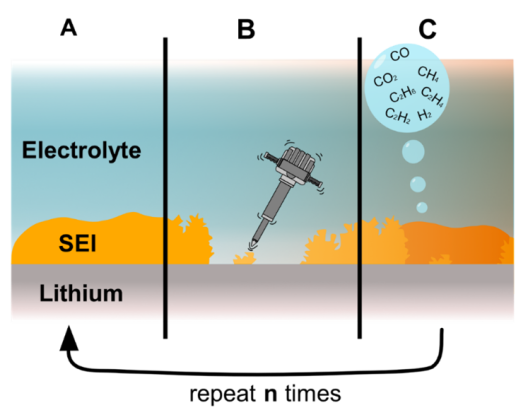Innovative Method Enables Analysis of Low-concentration Compounds in Lithium Metal Batteries
The Solid Electrolyte Interphase (SEI) in lithium metal batteries is crucial for the performance and lifetime of the battery but has not yet been researched sufficiently. In particular, the soluble and gaseous compounds that are formed as by-products of the interphase formation in the electrolyte need to be analyzed in more detail to gain deeper insights into the ongoing reactions. A new method to study exactly these compounds and also the SEI itself has now been developed by a team from MEET Battery Research Center at the University of Münster. It is based on accumulating the low-concentration compounds in the different phases during interphase formation to provide a sufficiently concentrated sample for analysis.

Qualitative and Quantitative Analysis of SEI and By-Products
Many compounds that are formed at the interphase between the lithium metal anode and the liquid electrolyte are too low concentrated to be analyzed by standard analytical methods. These techniques provide insights into the properties of the interphase, but were only in a few cases able to name defined structures that the SEI consists of. The new method developed by the scientific team therefore uses the intrinsic behavior of lithium metal to spontaneously react with the liquid electrolyte. “Our research interest was to figure out an easy way to access the compounds that form this specific interphase and allow to study the system as a whole and not solely the SEI,” explains MEET scientist Bastian von Holtum. “In total, our method allows to take a step forward towards a holistic model of the SEI on lithium metal in a robust, simple and inexpensive way, allowing both quantitative analysis about the presence of certain interphase compounds and qualitative studies on the organic and inorganic compound profile of the SEI.”
Detailed Results Available Online
The complete study has been published by Bastian von Holtum, Maximilian Kubot, Christoph Peschel, Dr Uta Rodehorst, Dr Sascha Nowak und Dr Simon Wiemers-Meyer, MEET Battery Research Center, and Prof. Dr Martin Winter, MEET Battery Research Center and Helmholtz Institute Münster, in the journal “ChemSusChem”.

